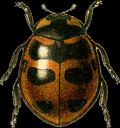Transverse Lady Beetle
Coccinella transversoguttata
Classification
- Phylum: Arthropoda
- Subphylum: Hexapoda
- Class: Insecta
- Order: Coleoptera
- Suborder: Polyphaga
- Superfamily: Coccinelloidea
- Family: Coccinellidae
- Subfamily: Coccinellinae
- Genus: Coccinella
- Species: transversoguttata
Pronunciation
How to pronounce Coccinella transversoguttata: //ˌkɒksɪˈnɛlə trænzˌvɜːrsəʊˈɡʌtə.tə//
These audio files are automatically generated. While they are not always 100% accurate, they are a good starting point.
Images





Summary
Coccinella transversoguttata, or the transverse ladybird, is a native ladybug species found primarily in North America and Europe. Known for feeding on aphids, its populations are declining potentially due to competition from introduced species.
Physical Characteristics
Length 5.0 to 7.8 mm
Identification Tips
The transverse ladybird can be identified by its distinctive pattern, with spots across its elytra. It may be confused with other ladybug species, especially Coccinella transversalis, which has a similar common name.
Habitat
Primarily found in gardens and agricultural areas where aphids are prevalent, especially in the Rocky Mountains during the warmer months.
Distribution
Historical range is worldwide in the Northern Hemisphere, with current frequent sightings in the Rocky Mountains and documented presence across North America from California to Virginia and Labrador to Alaska, including Greenland.
Diet
Aphids
Conservation Status
Considered a Species of Greatest Conservation Need (SGCN) in New York State due to population declines attributed to competition from introduced species.
Ecosystem Role
Aphid predator, plays a role in controlling aphid populations in its habitat.
Evolution
The decline in numbers is linked to ecological changes and competition with invasive lady bug species like Coccinella septempunctata.
Misconceptions
Often confused with Coccinella transversalis due to the common name 'transverse ladybird', despite being distinct species, with different geographic distributions.
Tags
- ladybug
- Coccinella
- Transverse Lady Beetle
- invasive species
- conservation